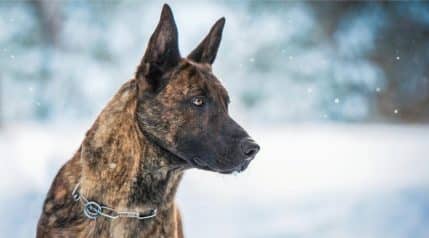Mixed breeds always bring an element of excitement and mystery into the realm of pet ownership. While you can have all the knowledge in the world about the two breeds that make up the mix, there’s never a definitive answer as to what you’ll get from their pups.
Mastiff Lab mixes, also known as Mastadors, are no different. These floppy, lovable dogs are the result of a Mastiff mixed with a Labrador Retriever. There are other Mastiff mixes, like the American Mastiff which came about when the Anatolian Shepherd was bred into the line many years ago.
If you’re okay with the question marks that come with owning a mixed breed, then by all means, dive into puppy parenthood. However, learning more about the two purebreds that make up this mix can certainly help you care for your pet properly. Let’s take a look at this mixed breed along with the parents that create it.
History
Mastadors, as we mentioned, are a crossbreed of the Mastiff and the Labrador Retriever. Because of their gentle nature with small children, both the Mastiff and Lab are often compared to one another as family pets. With floppy ears and big eyes, this mix makes for an adorable breed and a popular family pet. Their big, friendly face is likely to draw anyone in, and their active nature makes them great outdoor companions.
Though their larger size can be a bit intimidating to newcomers, Mastadors are notoriously sweet. Adaptable and fun-loving, a good family can keep this mixed breed very happy.
Although we will certainly learn more about the Mastiff Lab mix, it’s usually best to start with the purebred parents to get a better idea of what traits the pup might adopt.
The Mastiff
The Mastiff dog breed has been around for a very long time. Many experts believe it was brought to America from England, via Asia. The name is also believed to have come from the French word Mastin, which means watchdog.
This appropriate name was given to these large dogs who were often used to guard both livestock and homesteads from wildlife and thieves. Their loyalty was unmatched, which ended up making them excellent pets for companionship as well as protection.
Mastiffs are certainly on the larger size. At the bare minimum, a Mastiff will usually come in at about 30 inches tall at the shoulder. Their weight can be anywhere from 130 to 220 pounds. Their great size and strength were what made them so attractive for those in need of protection.
This breed sports a short, straight outer coat accompanied by a dense and even shorter undercoat. Their colors range from fawn to apricot to brindle, and some of these variations can include dark strips. The most notable feature of the Mastiff is their dark brown or black nose, ears, and eye rims.
Most mastiffs have short fur but they can have long hair as well. As a result, Mastiffs do tend to shed and require some grooming and brushing.
Mastiffs boast personalities of bravery, loyalty, and protectiveness. Though they are great with strangers and will approach anyone with friendliness, they have the natural ability to sense dangers and threats. Should they feel something isn’t right, they will not hesitate to protect their master.
In fact, the Mastiff has been known to step between any sort of escalation—even an argument between siblings or spouses. Needless to say, this breed doesn’t like conflict. Bullmastiffs, when compared to English mastiffs, can be a little bit more assertive and flat out territorial.
However protective, though, this dog has a sensitive interior that can produce traits of shyness, fear, or aggression if he is not properly trained, loved, and treated. But, good families, plenty of exercise, and socialization make Mastiffs great family pets and protectors with undying loyalty and fun-loving spirits.
The Labrador Retriever
The Labrador Retriever is America’s most popular dog breed, and for good reason. Appropriate to its name, the Labrador was originally—and still is—used for hunting. They are very smart dogs who take commands well, working with their masters to flush and retrieve birds.
Though they are useful practically, the breed has long been known for its kind and loving temperament and loyalty. The friendliness of this breed is unmatched, making them great for any dog owner, new or old. Families love Labs because of their excellent companionship.
Labradors are social butterflies. Not only will they love you, your family, and your family’s friends, but they do great with other dogs as well. They love to play, and they need a good amount of exercise. They certainly have high levels of energy, as they are natural athletes who love running, fetch, swimming, and any other game you can come up with.
Labrador Retrievers are typically 21 to 25 inches tall. They generally weigh between 55 and 80 pounds, depending on their health and sex. They have thick, hard coats that come in a variety of colors, from yellow to black to chocolate. You may also recognize them from their long, thick, wagging tails.
Traits
When you’re dealing with a mixed breed, learning about their parents will always be beneficial. Now that we’ve gone through some of the purebreds’ basics, we can delve into the Mastiff Lab mix.
A Mastiff Lab could look more like the Mastiff half or more like the Lab half. In the same way, it can widely vary in size. Mastiff Labs can grow to be anywhere from 50 to 130 pounds. Since that leaves their adult size up to chance, it’s good to make sure you’re okay with the unknown in this breed.
A good way to get a better idea of your mixed pup’s adult weight is to look into how big both of their parents were. However, there’s a good chance your dog will be pretty big in general given that both breeds are medium-sized or larger.
As far as their coloring goes, that will depend largely on the color of the Labrador half. Though your Mastiff Lab will inherit its color from both parents, the Lab typically has a wider range and therefore can have a big impact on what the mixed pup will look like.
That being said, your pup may have the dark face of a Mastiff or could be completely black like the Lab.
Grooming
Though their Lab half may invoke some shedding, a Mastador typically has short hair and oily skin, which makes it easier for the breed to self-clean. Their ability to take care of their own coat makes life easier for you; however, there are still a few things you should do for your Mastiff Lab in terms of grooming.
Mastadors like to play in the water, and so they will require some maintenance. Their self-cleaning allows you to limit baths to perhaps once a month, but their ears require much more attention. To avoid infections, you should regularly clean and check your Mastador’s ears.
Additionally, it’s wise to brush this breed’s coat once a week. Doing so will help spread their natural oils as well as remove loose hairs to promote new hair growth. You should also clean their paws regularly since they are pretty active.
Exercise
While Mastiffs only need some exercise to stay happy, Labradors are very active and athletic. The mix of moderate to high energy levels will likely give you a pretty active mix.
Training and playtime are very important with Mastiff Labs. If you want your pup to be not only happy but well-behaved, you need to make sure you put enough time into keeping them busy and moving.
You should take your Mastador for daily walks, or at least let them run around in an open space like a dog park or a large yard. In addition, they’ll love going with you for runs, playing games, and long training sessions.
While lack of proper exercise may not increase levels of aggression in your Mastador, as his docile Mastiff side will take over, it can negatively affect their overall health and fitness.
Nutrition
Since Mastadors are active dogs, they require a good amount of sustenance. They are more active than regular mastiffs, but not quite as active as labradors. Because of their size, they will need a dog food that’s made specifically for large breeds, like our favorite foods for mastiffs we’ve selected here. Not only do they burn a lot of calories running around all day, but they’re on the larger side, so they will eat more than smaller breeds.
A Mastiff Lab will do best eating high-quality dry dog food. They may eat as much as three cups per day. However, Labradors are known for eating anything in sight. Because of that trait, your Mastador could do the same. While you need to make sure they eat enough to stay healthy, you should also make sure they aren’t eating too much.
Health
Because they are a mixed breed, the Mastiff Lab is less likely to take on genetic health issues that a purebred may have. However, that doesn’t make them immune from illness or injuries.
Since Mastadors are large dogs, they are prone to large dog issues like heart problems and hip dysplasia later in their life. Additionally, any dog with large, floppy ears requires regular cleaning, as they are more likely to get ear infections and foul odors.
Labradors are also more prone to obesity given their insatiable appetites and the need to eat everything they see. As we mentioned with the Mastador’s appetite, it’s important to not only ensure they’re getting enough nutrients but that they aren’t eating too much.
Personality
Such as with every mixed dog, your Mastiff Lab’s personality and temperament will differ from the next Mastiff Lab. This is very common with crossbreeds.
However, it’s safe to say that your Mastador will likely be very friendly and outgoing. Based on the traits of its parent breeds, this mix will be loyal, protective, and loving. They make great family dogs and are very good with kids.
When you mix the loyalty of a Lab and the protective nature of a Mastiff, you get an excellent guard dog. Though it’s not known to be aggressive towards people or other animals, it will likely sense threats and danger and will jump in between conflict in favor of their master, family, and territory.
Mastiff Lab mixes do best when they are active and well-socialized. If you have a family who is gone for long periods of time throughout the day, this breed probably isn’t for you. When left alone or bored for too long, your Mastador may become destructive and display signs of anxiety.
Training
Mastiff Lab mixes are very smart dogs, so training shouldn’t be too much of an issue. In fact, they are generally pretty easy to train. Mastadors tend to display the ability to pick up commands and tricks easily and quickly.
While your Mastiff Lab needs a solid master or “pack leader,” they will do well with multiple trainers, unlike other breeds who will only listen to their master. This is great for family situations, where everyone can participate in the training and take turns watching your pup.
Frequently Asked Questions
You can never have too much information about your mixed breed. While we have provided a lot of good knowledge for you already, we know that you may still have some questions. Check out a few of these commonly asked questions and their answers.
Q: How long do Mastiff Labs live?
A: Mastadors usually live anywhere from 10 to 15 years. Remember that this is on the assumption that they are healthy. To ensure you Mastador gets the most out of their lifespan, you need to keep up with proper nutrition, exercise, vet visits, and grooming.
Q: How much do Mastiff Labs cost?
A: Because Mastadors are a newer mixed breed and are considered a designer dog, they can be a bit pricey. Breeders can charge as much as $2,000 for this pup. This is also considering how popular and excellent Labrador Retrievers are, which makes their part in the mix very important and desirable.
Q: Are Mastadors good hunting dogs?
A: Yes! While the Mastiff was originally used as more of a guard dog, the Labrador Retriever makes an excellent hunting dog. Both of these breeds are highly trainable and loyal, so hunters can certainly train them to come along on their expeditions to flush and retrieve game.
Final Thoughts
The idea of a slightly unpredictable, large dog can be a little intimidating to new pet owners, but once you get to know the breed some more, it becomes much easier. Though the Mastador is large and in charge, it is so loyal, loving, and friendly.
An excellent family dog, you’ll soon find that this massive beast has a tender heart and a dedication to protecting his family.
With a little bit of exercise, consistent training, and a lot of love, you will find yourself a great companion is the Mastiff Labrador mix.






OUR LOVING MASTADOR PASSED AWAY ON APRIL 27, 2023 OF CANCER OF THE SPLEEN, HE WAS 12 YRS. 😭
THERE IS NOTHING LIKE A MASTADOR’S EYES!! THE LOSS IS UNBEARABLE. SO SO MANY WORDS TO DESCRIBE TO GREAT FUN LOVING PERSONALITY!!! HIS (MOUNTAIN CUR) IS SO LOST, INCLUDING OUR 2 CATS.
RAEGAN CHOSE OUR OTHER DOG FROM 11TH HOUR. WE WE SURPRISED HOW MANY LIVES HE TOUCH!!!
We just adopted a lab retriever mastiff mix from our local shelter here in Bossier City Louisiana . Chloe is black with white from her neck down her chest she’s so pretty we have had her 2 weeks now . She’s so sweet and smart gone into protective mode 2 times now . She loves playing with our lab beagle mix . Loves her new sister ! She’s 10 months and 60 pounds so far . Curious to see exactly how big she gets .
Would be more than interested!
Had Labs for years and recently moved in with my daughter and her family which includes a huge Corso. Money might be an issue as I am on social Security.
Thanks!
Thanks for the long article! So true that the temperament shifts a lot between different mastiff breeds.
Thanks for the ambitious article. I must agree that the Mastiff lab differs from some other Mastiffs in terms of personality, yet shows traces similar to the Tibetan Mastiff and Great Dane (to mention a few). As such, you may get an intelligent and loyal guard dog in the Mastiff Labrador. Thanks for the article, I enjoyed it.
I live in the Quad Cities. Are there any breeders in my area?
Not sure but perhaps talk to a local breeder of Labs or Mastiffs to see if they have any leads. Good luck, Chuck!
I recently lost my Brazillian Mastiff to degenerative arthritis and pathological fractures post knee replacements. He was the most wonderful and precious animal I ever had. I want another Mastiff breed without all of the health issues. Thanks for any further information.
Hi Barbara! Mastadors are great dogs. I actually own one. Less hyper than a Lab, but friendlier than my purebred mastiffs. She truly feels like a combination of both breeds. I love them all, and each has its own distinct personality. Mastiffs are great dogs, and so has every mastiff mix I’ve ever met. Good luck in your search!